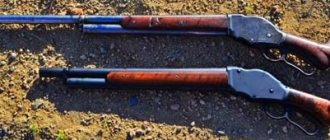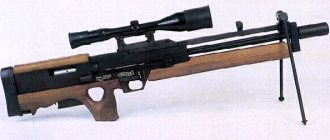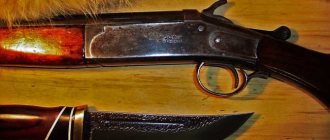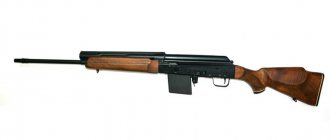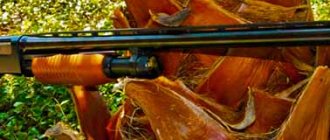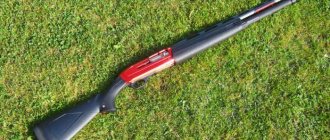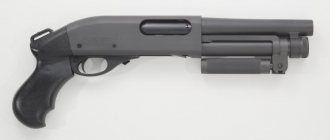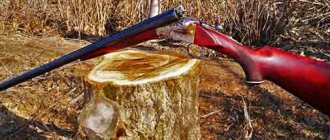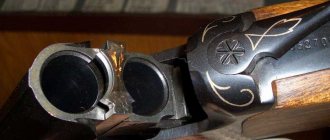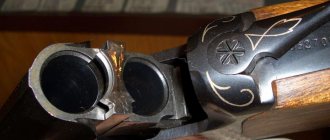As you might guess from the name, the Winchester M1897 pump-action shotgun was first manufactured in 1897 by legendary gun designer John Browning. The master created this shotgun based on his own early design from 1893. The Winchester Model 1893 was the first smoothbore shotgun with manual reloading using a longitudinally moving movable forend. Ammunition for the gun was 12 gauge smokeless powder. It was also planned to use 16 gauge for hunting.
Model 1893 was produced in a circulation of about 35 thousand copies. Having studied the features of using a shotgun, the gunsmith made certain changes to its design and modified it to a more successful model. The Winchester M1897 shotgun turned out to be a very successful product, and in the next 60 years after its first release, about a million units were produced.
Note that the gun is also known under the names of modifications Winchester M97, Winchester Model 97, Winchester Model 1897, Riotgun, Trench sweeper.
Historical reference
The Winchester 1897 shotgun played a huge role in the history of weapons, including directly for the United States, since it was practically the only gun that marked a new era in the development of smooth-bore weapons, the emergence and widespread use of repeating systems. The Winchester M1897 was the first truly successful pump-action shotgun.
Over time, it became the most popular shotgun on the American market and set the standard for performance. The Winchester M1897 shotgun was popular because the workmanship was high, the performance characteristics were good, and the action of the gun was excellent.
A fundamentally new product appeared on the market, which captured the minds and hearts of the population of the United States and determined preferences in weapons, becoming the favorite type of weapon of Americans for many years. Multi-charge systems on the American continent greatly displaced double-barreled guns, and self-loading systems that appeared somewhat later only strengthened their dominant position, which became a national feature of North Americans.
During World War I, a modified version of the Winchester M1897 was officially adopted as the Trench Gun Model 1917. The military modification differed from the base model in having a 510 mm cylindrical drill barrel, a ventilated burn guard installed on the barrel, and a bayonet mount. The gun still held 5+1 rounds. The standard military shotgun cartridge has become the 00 buckshot cartridge (according to the American classification), i.e. three in a row, a total of 9 buckshots with a diameter of 8.38 mm.
The appearance of the Winchester M1897 Trench Gun on the front was due to the extremely increased density of artillery and machine gun fire, which drove the World War into the trenches. The assault on these countless crevices and holes showed the weaknesses of the Springfield M1903 and Enfield long rifles in trench warfare. In addition, an unpleasant thing became clear: the advancing Allies in the German trenches were met with fire from the world’s first successful Bergmann assault rifle. This is where the Model 97 shotgun showed itself very well.
Allied assault troops began to use the “trench broom” en masse.
The main advantage of the Winchester M1897 was its great stopping power when shooting at point-blank range in a confined space.
The weapon turned out to be quite unpretentious for combat conditions, so if it misfired, a new cartridge was sent with a quick and simple movement of the hand. Having almost the same ammunition, and almost equal in rate of fire, the guns began to significantly surpass the revolver in terms of damaging effect. In addition, the Americans came up with the idea of \u200b\u200bpositioning good shooters with shotguns loaded with small shot in the front trenches in order to shoot down, or rather knock off, enemy grenades.
The psychological impact on the Germans was so great that on September 19, 1918, the German government issued a diplomatic protest against the American use of shotguns, arguing that the shotgun was prohibited under the law of war. After review of the applicable law by the Army's chief military prosecutor, Secretary of State R. Lansing rejected the German protest in a formal note.
The Winchester M1897 combat shotgun earned its place as the Army's secondary weapon, and by the end of the war, the US Army had over 20,000 "trench guns" in service, two-thirds of which were Winchester M1897s.
After World War I, short versions of the police version of the Riot Gun, without a barrel shroud and without a bayonet mount, were used to guard prisoners and mail, as well as to disperse crowds as a less lethal weapon.
The Winchester M1897 was used quite effectively by the US Army during World War II. The shotgun saw limited use in the US Army and Marine Corps, along with a similar 1912 version (Winchester M1912). The presence of a capacious tubular magazine, coupled with a faster reloading speed than bolt-action rifles, as well as a high destructive effect at short distances, made this weapon indispensable for fighting in trenches and indoors.
At the end of the twentieth century, the Chinese company Norinco launched the production of the Norinco 97 shotgun, which is an exact copy of the Winchester M1897 shotgun in the “Trench” and “Riot” versions.
MAKSIMOV.SU
The long list of manufactured hunting and combat weapons designed by J. Browning, as well as the intriguing stories about his particularly successful models, is a huge and fascinating area in the history of weapons.
One of the most famous designs of the legendary gunsmith is a gun with an under-barrel magazine and a lever-type bolt.
And the most interesting
from several modifications, can be called a repeating shotgun of the 1897 model, made in America.
Winchester M1897 shotgun
The history of the M1897
Patent
for a lever-action rifle was received by Browning on February 16, 1886. The first production shotgun of this design was the Winchester Model 1893, which did not become widespread due to “childhood illnesses” and, a few years later, was significantly modified by Browning.
This modification of the “93rd Model” became the first mass-produced repeating shotgun, widely known as the Winchester Model 1887 and giving rise to the cult of the “pump” on the North American continent. “97th” Winchester very quickly became one of the national American treasures, which has not faded to this day.
From now on, the “shotgun” for Americans was personified by the “Winchester” model of 1897, which, having confidently supplanted double-barreled guns, did not lose its position even with the advent of self-loading systems. Particularly about, which is one of the fetishes of American culture, has not lost its position in the USA.
Winchester M1897 shotgun
Design
Structurally, the M1897 represents that very successful combination of a whole set of various technical solutions, which leaves another milestone in the history of weapons.
Hunting rifles with an under-barrel tubular magazine are divided, roughly speaking, into 2 types - “pump” and semi-automatic. Both of them - initially, whatever one may say, they were Browning systems. The same Auto-5 cannot be considered without looking at the M1897.
Winchester M1897 shotgun
Lever reloading of this system ensures that the cartridge is fed into the barrel and the spent cartridge is extracted. Locking is ensured by a swinging cylinder. The magazine is tubular, holds 5 rounds, and is located under the barrel.
One of the most exciting features of the gun is the external trigger, which evokes vivid associations with revolvers, the Wild West and other romance of the harsh and eventful life of the heroes of the past. Its presence precludes the use of any safeties, and the ease of using a weapon with an external trigger is quite obvious.
Winchester M1897 shotgun
The gun's trigger allows for rapid shooting, with the trigger pulled and the fore-end vigorously twitched - the rate of fire is close to that of self-loading guns, with a higher degree of reliability. Although, of course, the shooting accuracy will not be the best.
Winchester M1897 shotgun.
Trigger position: in the lowered position, on the safety half-cock
Winchester M1897 shotgun,
cocked
Winchester M1897 shotgun.
The trigger is cocked, rear view
Winchester M1897 shotgun.
The simple rear sight on the front of the receiver does its job perfectly.
Winchester M1897
produced in 12 and 16 gauges. The hunting modification had a barrel length of 711 or 760 mm. Weight for 12 gauge is about 3.5 kg, for 16 gauge - 3.4 kg. 16-gauge shotguns were produced only with a 65 mm chamber. For firing buckshot and bullets, a model with a cylindrical barrel 510 mm long was produced.
Features of operation
Hunting with a “pump”
Repeating shotguns
with an under-barrel magazine, when used for hunting, are generally more convenient and much more elegant than systems fed from a middle box magazine.
And their design is more classic and does not cause such rejection as the Saiga-12. The change in the balance of the gun as the grenade launcher becomes empty can in some cases be neglected, but the ability to quickly reload such a gun while hunting can hardly be overestimated.
Hunting with a pump-action shotgun in Russia is as untraditional as the “pump” is common in the USA. Our interest in pump-action cars arose solely thanks to Hollywood films that suddenly became accessible and the alarming post-perestroika years: in the 1990s. the demand for these weapons was enormous.
But in Russia, in an uncontrollable stream, there were mainly “pumps” of police modifications, more suitable for hunting people, which, incidentally, was required - the need for self-defense came first. For classic Russian hunts, various Mossbergs and Winchesters did not take root. And they couldn’t fit in.
Winchester M1897 shotgun.
The forend of the gun has a ribbed shape, which later became a classic one, which successfully prevents the hand from slipping when reloading the weapon.
Winchester M1897 shotgun.
The front part of the rifle's under-barrel magazine
Winchester M1897 shotgun.
Close-up of store equipment
Winchester M1897 shotgun.
Close-up of store equipment
Disappointment with the “pump” set in among Russian hunters quite quickly. And the global arms industry began to focus on the forgotten old - semi-automatic devices. And in the late 90s, the shelves of consignment hunting stores were filled with pump-action shotguns from a wide variety of manufacturers - hunters began en masse to switch to self-loading guns, simultaneously “discarding” boring “pumps” from their licenses.
It should be noted that now the progressive part of hunters is gradually abandoning semi-automatic weapons. People read the gun press and materials on the Internet, and, imbued with quite reasonable calls, return to the eternal classics - double-barreled shotguns. However, in the provinces they did not refuse “two-guns”, hardly even suspecting all sorts of delights of the modern weapons industry and fabrications in the field of “proper hunting”.
Winchester M1897 shotgun.
Feeding a cartridge from the magazine into the barrel
Winchester M1897 shotgun.
Feeding a cartridge
from the magazine into the barrel
Winchester M1897 shotgun.
The swinging cylinder reliably locks the bolt in the extreme forward position
For our hunter, who has watched enough American films and bought a pump-action shotgun, the use of the latter lies more in the field of animal hunting and according to the Hollywood principle: “I’ll kill everyone, I’ll be left alone.” Despite the fact that insight comes quickly, sometimes they actually hunt successfully with the “pomp”, either out of principle, or because people are really comfortable with it and aesthetics do not suffer for them.
Winchester M1897 shotgun.
Loading a gun
Winchester M1897 shotgun,
loading process
There is an opinion that this weapon is preferable for dangerous hunts: they say that a pump-action shotgun is more reliable than self-loading and there are more cartridges in the pump-action magazine than in the barrels of a double-barreled shotgun. Of course, a gun of any design, if you have some experience in handling it (and in the hands of an experienced hunter), can claim some kind of versatility, but for some reason the “pump” in our country can now only be found among tourists, sports shooters and “self-defense fighters.”
Winchester M1897 shotgun.
The swinging cylinder that locks the bolt is also a feeder of cartridges from the under-barrel magazine to the ramming line. Massive and reliable part. And what about the curtain that protects the gun mechanism from dirt! In modern “pumps”, locking is done, as a rule, by the barrel shank, so the feeder in them has an openwork shape and does not “fall out” into the lower window when reloading
Winchester M1897 shotgun.
The forend rod, which, when the forend is distorted, transmits an axial force to the bolt of the gun. The mark, usually found on the rod, is absent
What captivates the “pompukha” is its relative cheapness, simplicity of design, ease of maintenance and reliability. When shooting from a pump-action shotgun, it is possible to use cartridges with any gunpowder and any charge and projectile weights, which is usually rarely possible in semi-automatic devices. But, again, the reliability of the “pump” is guaranteed only with factory cartridges or a self-rolling cartridge with a new cartridge case - self-loaded cartridges with an uncalibrated spent cartridge case can cause delays.
Winchester M1897 shotgun.
The trigger has a travel limiter, which minimizes the “failure” of the trigger and significantly reduces the likelihood of “pulling.” For effective fast shooting, a trigger travel limiter will also not be superfluous.
Trench broom
During the First World War
a significantly modified version of the Winchester M1897 was officially adopted, receiving the name "Trench Gun Model 1917". The military modification differed from the hunting model by having a cylindrical drill barrel shortened to 510 mm and a ventilated burn guard installed on the barrel.
A special bracket was provided for attaching the bayonet. The military cartridge for the M1897 was loaded with 00 buckshot (according to the American classification), a total of 9 buckshots with a diameter of 8.38 mm, three in a row. Quite a large buckshot, previously I was sure that 4.5 mm shot was used in combat shot cartridges, also 00, only according to our classification.
shotgun
.
Once upon a time,
Working in emergency surgery, I had a chance to see the result of the impact of “our” “two zeros” on a person, from a distance of about 10 meters: a large shot “works” terribly effectively. Larger shot, and even more so 8-mm buckshot, is capable of clearing the road from the enemy at much greater distances.
From the history of WWII, there are cases of extremely successful use of the M1897, for which it was nicknamed the “trench broom.” In trench conditions, the “pump” turned out to be a completely reliable gun; only damp and swollen cartridge cases caused problems.
In the American army, the pump-action shotgun was called a “trench sweeper.” During WWII, the need for weapons of this kind arose after the rapid transition of maneuver warfare into positional confrontation. The troops dug into the ground: they went into full-profile trenches and powerful dugouts.
When breaking through the front, assault groups were forced to use short-barreled and bladed weapons, grenades and sapper blades - even the relatively short British Lee-Enfields were inconvenient for close combat in the trenches.
The time has come for submachine guns and cheaper, but no less effective weapons - combat shotguns. The stopping effect of buckshot, especially when fired almost point-blank in limited space, turned out to be an extremely effective argument in trench battles.
The shotgun turned out to be quite unpretentious for combat conditions, which was the reason for its wide distribution. Of course, M1897 had the greatest impact on the Germans precisely in psychological terms.
It got to the point that on September 19, 1918, the German government issued a diplomatic protest against the American use of shotguns, arguing that the shotgun was a prohibited weapon. However, after reviewing the law by the chief military prosecutor of the American army, the German protest was rejected - the Americans, as usual, turned out to be right.
By the end of WWII, the US Army had about 20,000 pump-action shotguns in service, two-thirds of which were M1897 Winchesters. After the war, short modifications of the “pumps”, in the police version - without a bayonet bracket and without a casing on the barrel, were used for guarding prisoners, postal transport, and also for dispersing crowds, receiving the name “weapons of disorder.”
During WWII, they did not forget about the M1897 - it, together with the 1912 modification, was effectively used by the US Army. The Winchester M1897 was produced until the mid-1950s. Over 60 years, more than one million guns of this model were produced. Currently, replicas of the Model 97 are produced in China by Norinco.
Conclusion
M1897,
in addition to its interesting design, it attracts with its long and exciting history. Many hunters and lovers of old weapons like this gun for its quality and materials - the Winchester is well made from steel and walnut - the time for alloys and plastics has not yet come.
The system is reliable (the gun inspires trust just by its appearance), charismatic, has excellent performance characteristics and is quite rare in Russia, which makes it possible to call the M1897 a collectible gun, deserving, if not recognition, then sincere respect.
Winchester M1897 shotgun
The article was published in the magazine "Master Gun"
General description of Winchester M1897
Externally, the Winchester model 1897 looks like a classic pump-action shotgun with a tubular magazine. The hunting rifle is equipped with a small receiver made of gun metal.
The barrel is locked by a movable cylinder that blocks the rearward movement of the bolt; the trigger mechanism is single-action and does not have a disconnector, which allows the shooter to fire by moving the fore-end forward while simultaneously pressing the trigger.
The trigger is open, as in the usual versions of Winchester shotguns. In this regard, the sample does not have a separate fuse. The cartridges are supplied from an under-barrel magazine of not the largest capacity, and then, after firing, charging is performed - one cartridge at a time is fed into the window located at the bottom of the barrel box. Through the window located on the right side of the box, spent cartridges are ejected.
For aiming there is only a front sight and the upper surface of the barrel box, which replaces the aiming rib. Walnut wood is used to make the butt and fore-end.
World weapon legends. Winchester 1897
Kalashnikov Media presents a new series of articles in which we will introduce our readers to legendary weapons from around the world. These will be historically significant, famous or simply interesting in design systems from different countries and periods.
We will begin our acquaintance with the legends with one of the most famous and successful smooth-bore shotguns with reloading with a longitudinally sliding fore-end (“pump action”), which predetermined the popularity of this class for the next hundred plus years - with the Winchester model 1897.
This gun was produced by Winchester Fire Arms Co for 60 years, from 1897 to 1957, with a total production of about a million guns of this system. This charismatic and easily recognizable gun is based on an 1890 patent obtained by now legendary gunsmith John Browning and his half-brother Matthew Browning. The first gun created on the basis of the brothers' patent was the 12-gauge Winchester model 1893 shotgun, but it was produced only for black powder cartridges. In 1897, the design of this gun was revised in the direction of strengthening and some improvement, and then the “ninety-seventh” Winchester began a triumphal march both across the United States and in many other countries. In addition to a large selection of purely hunting options with different barrel lengths, in different calibers and types of finishes, the “Ninety-Seven” was produced in a shortened “police” version. With the beginning of the First World War, on the basis of a police gun, a “trench” gun was created for fighting in the trenches, distinguished by the presence of a bayonet mount under the barrel and a metal plate on the barrel that protected the shooter’s hand from burns. It was such a serious melee weapon that the Germans, having become acquainted with it “from the muzzle”, tried to declare shotguns an “inhumane” weapon, contrary to international conventions. It must be said that against the backdrop of combat gases, tanks and heavy artillery, the shotgun did not look so scary, and the “trench Winchesters” successfully fought the entire First World War. They were then actively used in maintaining law and order (as well as in gang warfare) in the United States during the interwar period, and with the outbreak of World War II they again went into military service.
Despite the cessation of production of the Winchester model 1897 shotgun, its popularity turned out to be so great that its “unlicensed” copies are currently being produced in China, both in hunting and “trench” versions. Of course, the finishing quality of these copies is significantly inferior to the originals, but their price is also significantly lower than that of the “real” Winchesters that have already become collectibles.
How was this legendary shotgun constructed? The Winchester model 1897 shotgun had manual reloading using a fore-end that moved back and forth, located around the tube of the under-barrel magazine. The forend was connected by one rod to the two main elements of the unit for locking and feeding weapon cartridges - a swinging feeder and a bolt. The feeder was a massive part swinging in a vertical plane around a horizontal axis located in its rear part. With its front part, the feeder rested against a stepped protrusion in the lower front part of the bolt, preventing it from moving back and thereby locking the barrel bore before firing. The shot itself was fired using a trigger mechanism with an open hammer. When reloading, the backward movement of the forend first lowered the front part of the feeder down, releasing the bolt, then the bolt was pulled back, removing and ejecting the spent cartridge case and cocking the hammer. When the bolt reached the rear position, the feeder dropped even lower, so that the next cartridge from the under-barrel tubular magazine fell onto the tray on the upper surface of the feeder. When the forend moves forward, the feeder lifts its front part so that the cartridge on its tray is directed into the chamber, and the forward movement of the bolt sends the cartridge into the barrel. At the end of reloading, the bolt stops at the breech of the barrel, and the final movement of the fore-end raises the feeder all the way up, so that it locks the bolt again for the next shot.
A feature of the trigger mechanism of this gun was the absence of a disconnector, which made it possible to shoot without releasing the trigger - the next shot occurred immediately as soon as the fore-end came to the extreme forward position. During hunting, this method of shooting was of little use, but when storming enemy trenches or showdowns between police and armed gangsters somewhere in the industrial areas of Chicago during Prohibition, this method was often used.
The tubular magazine was loaded through the window below with the bolt closed.
As mentioned above, the Winchester model 1897 shotgun had a lot of options, including collapsible ones with a removable barrel. Most of the guns were equipped with fixed choke constrictions, but on a number of hunting modifications muzzle compensators of the Cutts system could be installed.
Concluding our story, we can mention that in the arsenal of the Kalashnikov concern there is also a shotgun with pump-action reloading, much more advanced in design and materials than the legend born in the 19th century. You can get acquainted with him using the link.
Design features
To manually reload the Winchester model 1897, you must first move the forend forward, and then all the way back and move it forward all the way. The forend is moved forward only if there was no previous shot, which unlocks the hard drive mechanism. But if shooting was carried out, then, thanks to the recoil force, a slight forward shift of the forearm is carried out independently.
The swinging cylinder locks and blocks the independent movement of the bolt back and the unlocking of the barrel channel by the trigger mechanism. The fastening of the bolt and forend was a steel rod located on the left, between the magazine and the short barrel.
The trigger of the police shotgun had an external open-type trigger, which made it possible to do without a fuse.
An interesting fact is that it is possible to squeeze the trigger and, vigorously moving the fore-end, fire. This increased the effectiveness of shooting at short distances. It is clear that the accuracy of combat in such situations sometimes leaves much to be desired, but in close combat during the First and even Second World Wars, the shotgun proved itself to be excellent. And a hunter, if he was suddenly attacked by a large animal, could reliably defend himself.
Winchester Model 1897 Trench Gun. Why was this gun called a “trench broom”?
The result was not long in coming. “According to statistics, only 9% of shotgun victims, 50% of rifle victims, and 90% of pistol and revolver victims survive short-range shootings.” Diamond Martynenko. Magazine "Caliber" No. 2, 2004
By the way, the Germans, who were the first to use the MP-18 submachine gun in their reconnaissance groups, reported that the American grape shotgun was still more effective (one shot of grapeshot is equal in destructive power to nine shots from a pistol), but the lack of quick reloading significantly reduces its effectiveness, and completely focused on the development and improvement of submachine guns.
Like the history of many American pistols, shotguns, rifles and machine guns, the history of combat pump-action shotguns begins with the patent of the ingenious gunsmith John Browning. He introduced the first pump-action shotgun to the world back in 1893 (Winchester Model 1893). However, the gun was too “raw”. Browning sold the design, modified to the “required standard,” to Winchester, which began its production under the Winchester Model 1897 trademark.
For its time it was a breakthrough. 1897. Let me remind you that at the end of the 19th century, breech-loading guns only replaced ramrod muzzle-loading ones; in many armies of the world, rifles, the main combat weapon of infantry, were single-shot. They no longer fought with shots, but with bayonets. Machine guns were still only in the minds of inventors. And then... five cartridges in the magazine and one in the barrel were fired at the speed with which a person managed to jerk the fore-end. Unlike other Winchester repeating rifles of that time, which were reloaded with a Henry clip (fingers), the new design turned out to be much more reliable and less sensitive to various contaminants, although somewhat more complex.
Design.
Browning's new gun had an open hammer, like Winchester repeating rifles. The trigger, when closed, prevents the bolt from moving backward and eliminates even the possibility of a shot, so there is no need for additional fuses. The barrel is locked by a swinging cylinder that blocks the rear movement of the bolt. Reloading is a movement of the movable fore-end back and forth. Ejection of the cartridge case to the right. The trigger mechanism allows for firing when the trigger is pressed and the forend is moving. It turns out to be a sort of smooth-bore machine gun! At first the gun had a permanent barrel. Later, a modification with a detachable barrel gradually replaced the old one with a non-detachable one. The barrel was connected to the receiver with a sector thread and unscrewed together with the magazine for ease of transportation. The sighting device is only the front sight. The weight of the gun is approximately 3.4 kg, much lighter than rifles of those times.
Everything new finds its way difficultly. However, commercial agents have new guns everywhere - both in America and abroad. So, this gun came to Russia at the beginning of the 20th century, simultaneously with another John Browning gun, the Belgian-made Auto 5 semi-automatic. At the same time, however, the price of a pump-action gun was not very competitive, judging by Bitkov’s well-known weapons catalog for 1908, the price of a Winchester M1897 with a permanent barrel was 54 rubles, with a detachable barrel - 58 rubles. At the same time, the semi-automatic Auto 5 was not much more expensive - 80 rubles.
The First World War made this gun not just famous, but legendary. The use of pump-action shotguns by the American Expeditionary Force was so effective that on September 19, 1918, the German government issued an international protest against the use of shotguns by American troops. This protest was rejected, the motivation was that the Germans were the first to use chemical weapons, from which there were many more casualties.
It is noteworthy that the M97 "Trench Gun" made up more than a third of the combat shotguns of the American Expeditionary Force. It was these that the American infantrymen called not “Trench Gun” (trench weapon), but “Trench broom” (trench broom). Later this name was applied to many types of weapons.
Smooth-bore shotguns with pump-action reloading have proven themselves to be excellent in difficult combat conditions. According to such criteria as reliability, ease of use and shooting efficiency at short distances, they simply had no equal. In the event of a misfire or delay, the soldier could instantly reload the weapon, chambering the next cartridge. In total, more than 19,000 “trench guns” were sent to the American Expeditionary Force in World War I, approximately one per platoon of 25 men.
Almost thirty years passed, World War II. And again, “combat hard drives” are on the front line: Winchester M1897 and its later modification Winchester M12 (model 1912). Although, it would seem, military weapons have stepped far forward. But no, the war showed what it’s worth. From then until now, combat rifles have been used in the American army, police and special forces.
In total, more than a million copies of this wonderful gun were produced. Winchester Model 1897 is still in production. Both in the airsoft version and in real life. A complete copy of this gun called Norinco 97 (in the versions Trench Gun with a perforated casing and bayonet mount and Riot Gun, police series) is produced by the Chinese company Norinco. Moreover, the “trench version” of the Trench Gun costs much more than the nondescript “police” one. The airsoft version of this gun allows you to put empty cartridges into the magazine for a complete simulation of reality; when reloading, one cartridge flies out of the chamber, the other is loaded.
Tags: rifle, history of weapons, weapons, technology, inventions
Technical characteristics of Winchester M1897
Main characteristics of Winchester model 1897:
- Country of origin: USA.
- Produced in 12 and 16 gauge.
- The hunting modification had a barrel length of 711 mm or 760 mm. Basic barrel length 510 mm.
- The length of the gun is 1000 mm.
- Weight for 12 gauge is about 3.5 kg, for 16 gauge - 3.4 kg.
- 16-gauge shotguns were produced only with a 65 mm chamber.
- Full load of 5+1 rounds.
- For firing buckshot and bullets, a model with a cylindrical barrel 510 mm long was produced.
- Single-round firing mode.
- Effective firing range 20 meters.
Advantages and disadvantages
The Winchester M1897 was at one time a popular pump-action shotgun, one of the best in its class. Reliability, unpretentiousness and ease of use are the main criteria for its success. In addition, there were simply no clearly expressed negative aspects. The high efficiency of shooting at short distances allowed the Winchester 1897 to be actively used in trench warfare.
The disadvantages include not the best sighting device and the lack of original models in the form of options for left-handers. But when it comes to shooting almost point-blank, these qualities are not so important.
Note that the shotgun has not gained popularity as a weapon for hunting in most countries of the world.
This is due to the peculiarity of the pump action. The main drawback is reloading, during which a loud shutter click is heard. Such manipulations knock down the tab, and you have to re-aim.
When the shotgun was used actively, it was given greater preference than the double-barreled shotgun. But this is in cases of hunting large animals, because there was the possibility of rapid reloading, and five charges in the magazine and one in the barrel bore gave a clear advantage over a pair of barrels and instilled a certain confidence.
A clear advantage of such a gun is the use of cartridges with different powder loads. The operation of automation implies stability of the process with each shot, whereas in a hard drive this factor is not particularly important.
Modifications
Trench – this modification of the Winchester M 1897 shotgun appeared first. There were no combat shotguns of this class used to arm the army. During the First World War, the Winchester was adopted by the US Army under the name Trench Gun Model 1917.
The Winchester model was distinguished by a shortened barrel with a length of 508 mm; it was the first to use a ventilated barrel casing, protecting the shooter’s hands from possible burns after contact with a hot barrel. It also provided for a bayonet mount, which looked more like a long cleaver and was even used separately from the gun. It came with a sheath for carrying on a belt. The military most often used 12-gauge loaded with buckshot, occasionally using bullets of the same size.
The Winchester 1897 rifle was also used by Marines during World War II as an effective weapon in street combat. High demand required the hard drive to have good quality and positive results in combat and service situations.
Therefore, the next version of the Trenchgun was the Winchester model 1918 - a model with updated characteristics, which gave the shotgun a good acceleration. It was equipped with a non-removable barrel, but a little later a new modification saw the light of day, the barrel of which was connected to the box with a threaded connection, and it could only be separated with a magazine.
Riot is another modification, characterized by adaptation to police units. The Riotgun Winchester and the Trenchgun shotgun were essentially the same, but the police version did not have a bayonet mount or casing. In addition to law enforcement units, the model was lovingly bought up in American markets.
In addition to the above, there are also modifications that differ slightly in purpose, barrel size and external decoration. These include Standard Field, Fancy, Standard Trap, Special Trap, Pigeon, Tournament, Brush and Brush Takedown.
Winchester M1897, in addition to its interesting design, attracts with its long and exciting history. Many hunters and lovers of old weapons like this gun for its quality and materials. The shotgun is well made from steel and walnut, because the time for alloys and plastic has not yet come.
The system is reliable, charismatic, has excellent performance characteristics and is quite rare in Russia, which makes it possible to call the Model 1897 a collectible gun, deserving, if not recognition, then sincere respect.
